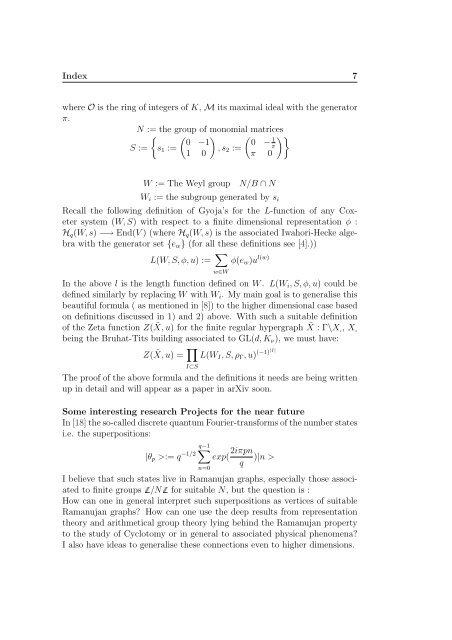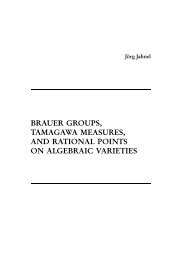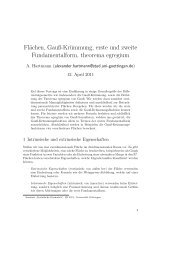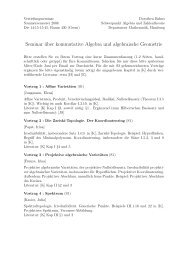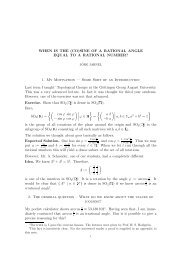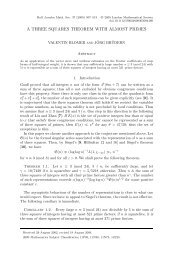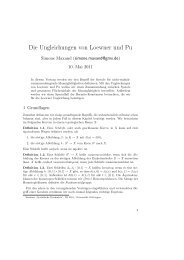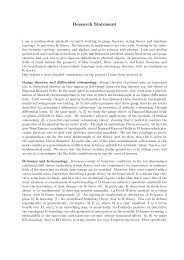Teaching Statement and Statement of Research Plans - GWDG
Teaching Statement and Statement of Research Plans - GWDG
Teaching Statement and Statement of Research Plans - GWDG
Create successful ePaper yourself
Turn your PDF publications into a flip-book with our unique Google optimized e-Paper software.
Index 7<br />
where O is the ring <strong>of</strong> integers <strong>of</strong> K, M its maximal ideal with the generator<br />
π.<br />
N := the group <strong>of</strong> monomial matrices<br />
S :=<br />
{<br />
s 1 :=<br />
( 0 −1<br />
1 0<br />
)<br />
, s 2 :=<br />
( 0 −<br />
1<br />
π<br />
π 0<br />
)}<br />
W := The Weyl group<br />
N/B ∩ N<br />
W i := the subgroup generated by s i<br />
Recall the following definition <strong>of</strong> Gyoja’s for the L-function <strong>of</strong> any Coxeter<br />
system (W, S) with respect to a finite dimensional representation φ :<br />
H q (W, s) −→ End(V ) (where H q (W, s) is the associated Iwahori-Hecke algebra<br />
with the generator set {e w } (for all these definitions see [4].))<br />
L(W, S, φ, u) := ∑ w∈W<br />
φ(e w )u l(w)<br />
In the above l is the length function defined on W . L(W i , S, φ, u) could be<br />
defined similarly by replacing W with W i . My main goal is to generalise this<br />
beautiful formula ( as mentioned in [8]) to the higher dimensional case based<br />
on definitions discussed in 1) <strong>and</strong> 2) above. With such a suitable definition<br />
<strong>of</strong> the Zeta function Z( ˜X, u) for the finite regular hypergraph ˜X : Γ\X . , X .<br />
being the Bruhat-Tits building associated to GL(d, K ν ), we must have:<br />
Z( ˜X, u) = ∏ L(W I , S, ρ Γ , u) (−1)|I|<br />
I⊂S<br />
The pro<strong>of</strong> <strong>of</strong> the above formula <strong>and</strong> the definitions it needs are being written<br />
up in detail <strong>and</strong> will appear as a paper in arXiv soon.<br />
Some interesting research Projects for the near future<br />
In [18] the so-called discrete quantum Fourier-transforms <strong>of</strong> the number states<br />
i.e. the superpositions:<br />
q−1<br />
∑<br />
|θ p >:= q −1/2<br />
n=0<br />
exp( 2iπpn )|n ><br />
q<br />
I believe that such states live in Ramanujan graphs, especially those associated<br />
to finite groups Z/NZ for suitable N, but the question is :<br />
How can one in general interpret such superpositions as vertices <strong>of</strong> suitable<br />
Ramanujan graphs? How can one use the deep results from representation<br />
theory <strong>and</strong> arithmetical group theory lying behind the Ramanujan property<br />
to the study <strong>of</strong> Cyclotomy or in general to associated physical phenomena?<br />
I also have ideas to generalise these connections even to higher dimensions.


